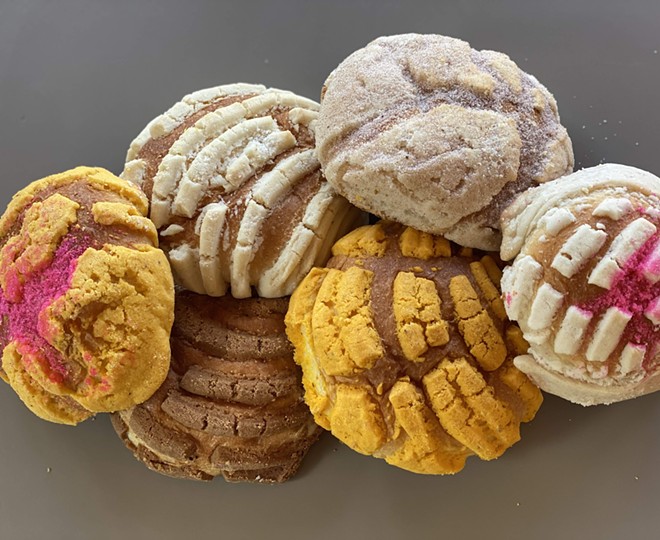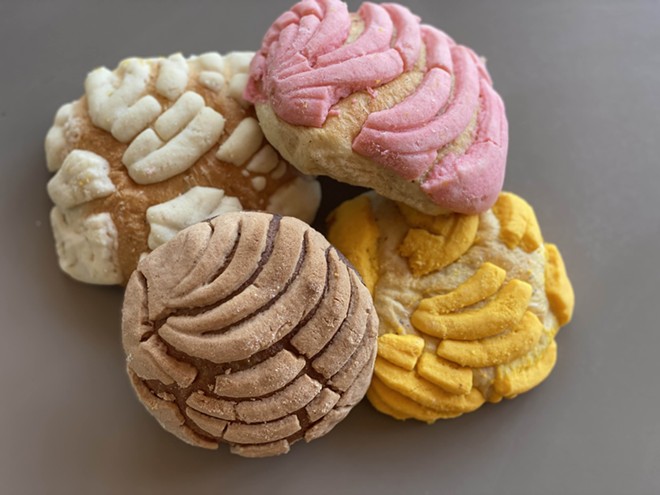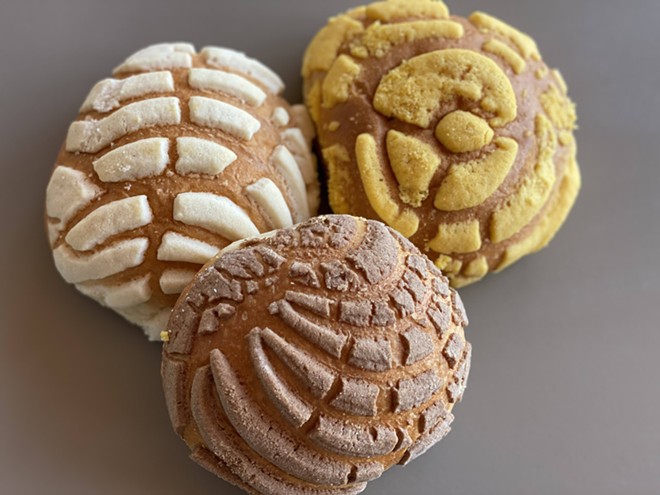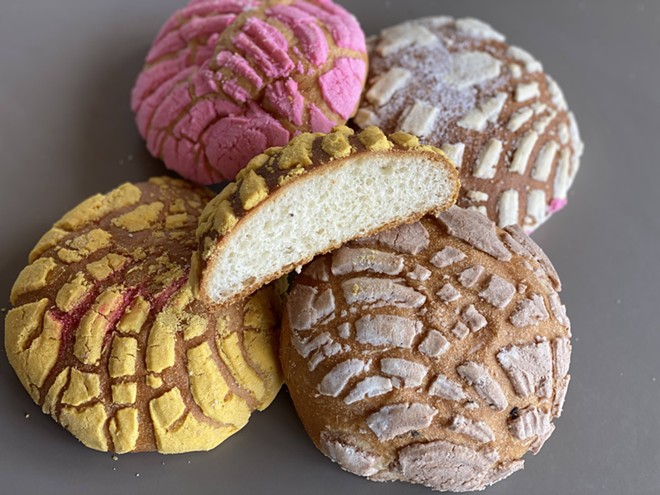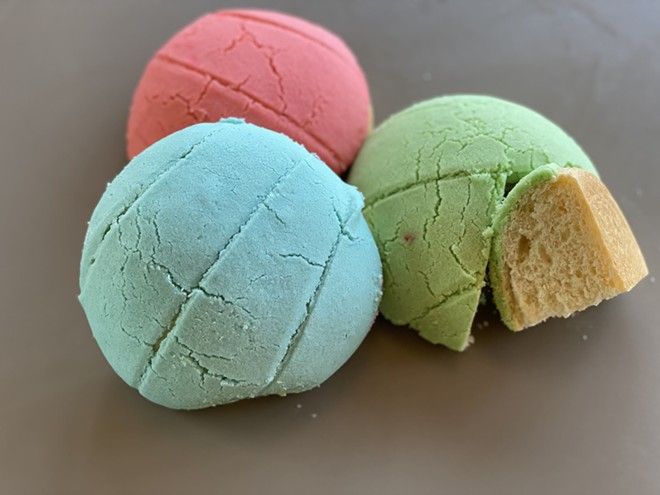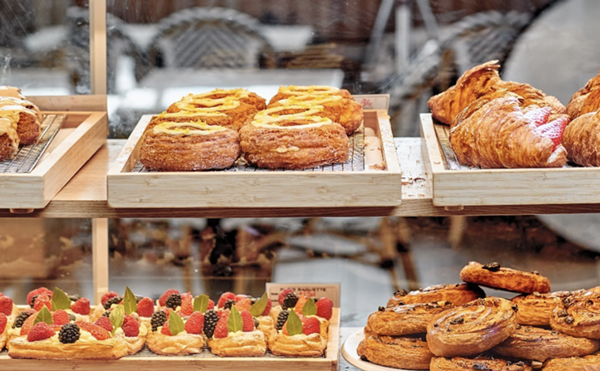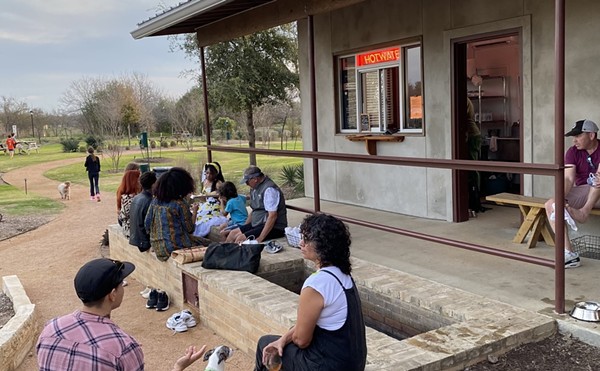The seashell has been an important symbol in Catholic iconography at least since the Middle Ages, when it became associated with Saint James the Apostle. The pilgrimage site of Santiago de Compostela in Northwestern Spain is the place most associated with both saint and symbol.
Unbeknownst to the venerable apostle and his followers, the shell had long been linked with another, ancient religious icon an ocean away. The Mexican god Quetzalcoatl, the plumed serpent, is also said to be connected to the shell, or concha, and the temple devoted to him at Teotihuacán near Mexico City features them prominently.
Mexican pastries, which appeared after the arrival of the Spanish with their preference for wheat flour over corn, didn't stand a chance: the newly minted indigenous bakers combined the best of both worlds in their ever-inventive forms and designs, and among the most popular of those forms was the concha. In the panaderias of today's San Antonio, it is, hands down, the most ubiquitous pan dulce, even if its mestizo symbolism is likely long forgotten.
Sometimes called a mollete or simply pan de huevo (egg bread), the shape is a simple domed circle of yeasted dough with sugar, eggs, water or milk and lard or butter. Frequently flavored with anise seed — and less often with stick cinnamon — the bread gets most of its sweetness and textural appeal from a ribbed coating of confectioner's sugar, flour, vegetable shortening and, most commonly, vanilla.
In a recent New York Times article, Mexican cookbook author Pati Jinich calls the concha "a pillar of Mexico's culinary identity" and goes on to deliver a recipe that has ten steps and takes an hour and a half active time as well as four to 24 hours rising time. Oh, and don't forget some baking skill and the suggestion that the home cook acquire a "concha mold" for impressing the shell pattern on the topping. No way, José. With more panaderias in San Antonio than Starbucks outlets, the obvious way to raise my concha consciousness was to do a drive-around.
Bedoy's Bakery (803 W. Hildebrand Ave., bedoysbakery.com), "since 1961" according to its sign, first came to my attention years ago as a premier purveyor of Day of the Dead breads. This spot's conchas flaunt deeply scribed shell patterns in white, yellow and cocoa. As is the case pretty much everywhere, the colors are there simply "para decoración" since vanilla is the only flavoring. The exception is the cocoa, which is modestly chococlatey. The bread itself is lofty, open, lightly sweet and includes a slight flavor of anise. As is the case almost everywhere, it needs the topping to make it compelling.
At El Folclor Bakery (multiple locations, instagram.com/elfolklorbakerysa), the conchas are on the flatter end of the scale and a tad dry, but the anise flavor is more prominent than some. The luminous pink topping on one of the conchas made me wish that it had an actual flavor, but no. Pink just tastes sweeter somehow. The thickness of the cap reminded me that the rayos aren't just there for symbolism. They work like little fault lines that keep the entire top from shattering apart when you take a bite.
Cinnamon comes into play at Fiesta Bakery, (multiple locations) with a chaotic-looking concha topped with cinnamon sugar and another more classically formed with a cinnamon-flavored shell. In a burst of decorative exuberance, there's a yellow-topped version with pink sugar filling in some of the valleys, while a white-shelled version flaunted pink sugar accents. The breads themselves are light and airy with a faint hint of anise.
The Pleasanton Road outpost of La Popular Bakery (multiple locations) was the longtime favorite of a friend's father, and though this spot offers small "conchitas," it was the least promising at first glance. However, it delivered on many fronts. The bread was open but with good structure, a distinct flavor of anise shone through and the generous topping offered more vanilla too. In short, surprisingly good.
A Fiesta edition concha immediately caught the eye of a visiting three-year old while testing the haul from Panifico Bake Shop (602 NW 24th St., panifico.com). Dressed up like Mardi Gras and more, it won the prize for outrageous enthusiasm in decoration. The open yet sturdy texture of the bread served the Fiesta topping well — as it also did for the deeply ribbed chocolate version. But perhaps the most intriguing item in the bag was the volcán, a concha variant consisting of a classic center with a diamond crosshatch ringed with a band of anise-scented pie-like pastry. A sprinkle of pink sugar suggested a fiery caldera contained by the contrasting crust.
From there, the survey moved a little more uptown. But it shouldn't be surprising that if you pay more than a dollar or so per piece — or, in one case, a lot more — you get additional flavor and staying power. La Panadería (multiple locations, lapanaderia.com), with its Mexico City roots, has been around for several years now. At its original Broadway location, one must turn a blind eye to temptations such as a croissant-concha mashup called the Croncha if adhering to a classic concha quest. The lofty domes are covered with tautly stretched skins, in vanilla or chocolate, that have been minimally scratched to suggest the bread's origins. The crunch of the thin shell contrasts beautifully with the tender, flavorful interior. Worth every bit of $2.50.
Just south of Fort Sam Houston, the far-smaller Alebrije Bakery (1931 N. New Braunfels Ave., alebrijebakery.com) has been in place fewer than three months — at this location, anyway — but the husband-and-wife operation nevertheless exudes charm and well-developed professionalism. Despite a $4.50 price tag, Alebrije's conchas are the only ones sampled in this survey that I would make a conscious effort to go back for. To start with, the toppings' Easter egg colors are exquisitely bold. But in a reversal of the usual formula, the flavorful and appealing dense bread could stand on its own sans shell.
Hard as it was to keep from finishing all three in a single go, they were still delicious after two days, and one was tolerable even later without the need of a dunking in hot chocolate to revive it.
Whether you prefer your conchas old-school or upscale, here's a bit of good advice from a poster on prominent display at Alebrije: "Keep Calm y Concha On."
So many restaurants, so little time. Find out the latest San Antonio dining news with our Flavor Friday Newsletter.

